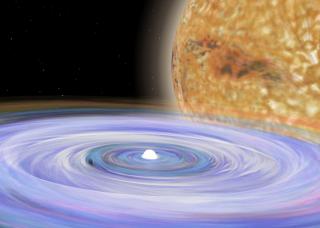Bibcode
Álvarez-Hernández, A.; Torres, M. A. P.; Rodríguez-Gil, P.; Shahbaz, T.; Anupama, G. C.; Gazeas, K. D.; Pavana, M.; Raj, A.; Hakala, P.; Stone, G.; Gomez, S.; Jonker, P. G.; Ren, J. -J.; Cannizzaro, G.; Pastor-Marazuela, I.; Goff, W.; Corral-Santana, J. M.; Sabo, R.
Referencia bibliográfica
Monthly Notices of the Royal Astronomical Society
Fecha de publicación:
11
2021
Número de citas
15
Número de citas referidas
11
Descripción
We present a dynamical study of the intermediate polar and dwarf nova cataclysmic variable GK Persei (Nova Persei 1901) based on a multisite optical spectroscopy and R-band photometry campaign. The radial velocity curve of the evolved donor star has a semi-amplitude $K_2=126.4 \pm 0.9 \, \mathrm{km}\, \mathrm{s}^{-1}$ and an orbital period $P=1.996872 \pm 0.000009 \, \mathrm{d}$. We refine the projected rotational velocity of the donor star to $v_\mathrm{rot} \sin i = 52 \pm 2 \, \mathrm{km}\, \mathrm{s}^{-1}$ that, together with K2, provides a donor star to white dwarf mass ratio q = M2/M1 = 0.38 ± 0.03. We also determine the orbital inclination of the system by modelling the phase-folded ellipsoidal light curve and obtain i = 67° ± 5°. The resulting dynamical masses are $M_{1}=1.03^{+0.16}_{-0.11} \, \mathrm{M}_{\odot }$ and $M_2 = 0.39^{+0.07}_{-0.06} \, \mathrm{M}_{\odot }$ at 68 per cent confidence level. The white dwarf dynamical mass is compared with estimates obtained by modelling the decline light curve of the 1901 nova event and X-ray spectroscopy. The best matching mass estimates come from the nova light curve models and an X-ray data analysis that uses the ratio between the Alfvén radius in quiescence and during dwarf nova outburst.
Proyectos relacionados

Estrellas Binarias
El estudio de las estrellas binarias es una parte esencial de la astrofísica estelar. Una gran parte de las estrellas de nuestra Galaxia y de otras galaxias se ha formado en sistemas binarios o múltiples, por lo que entender la estructura y evolución de estos sistemas es importante desde el punto de vista estelar y galáctico. Un aspecto en el que
Pablo
Rodríguez Gil